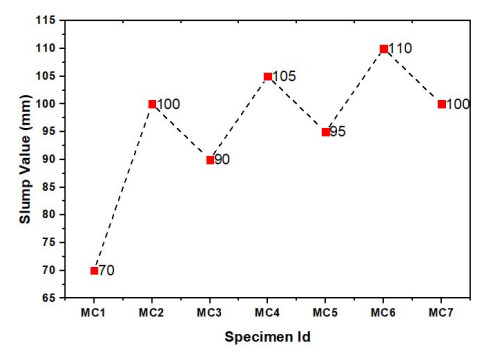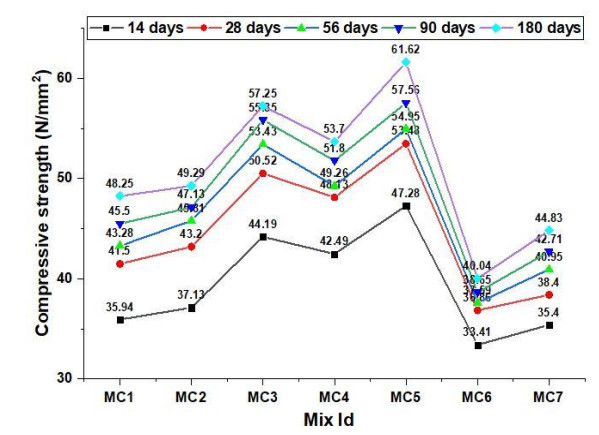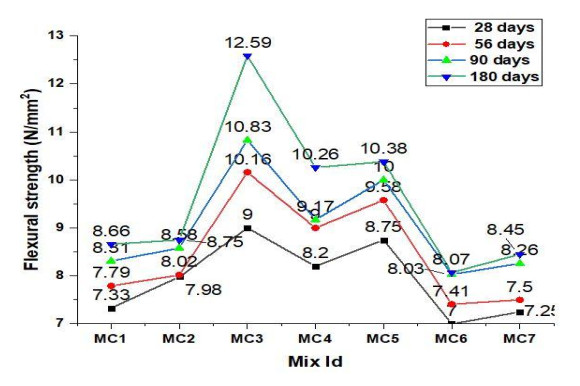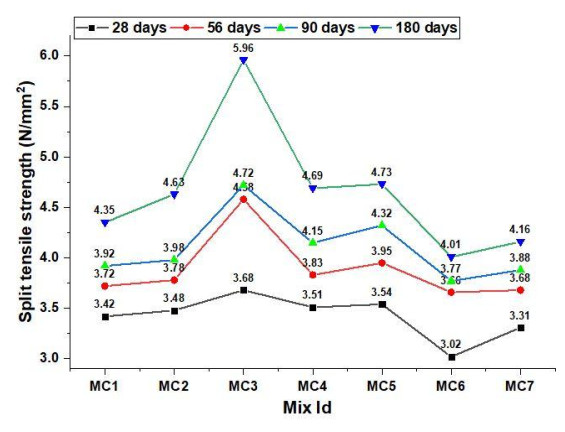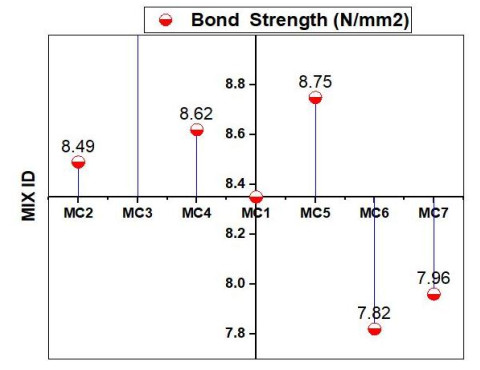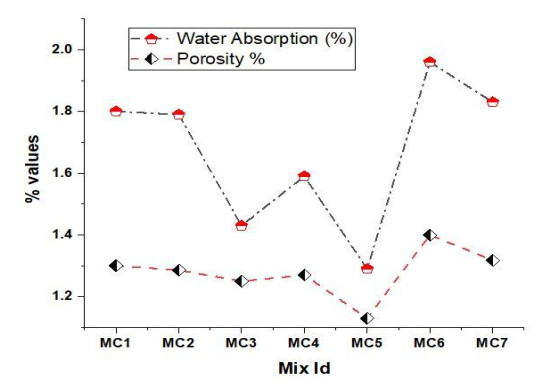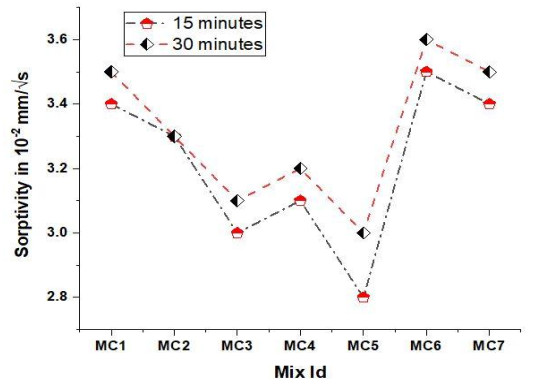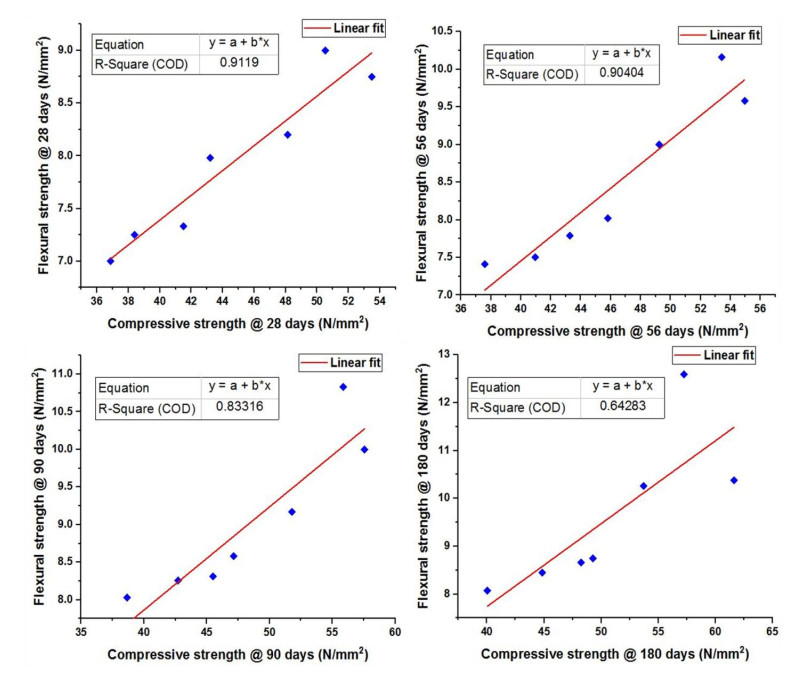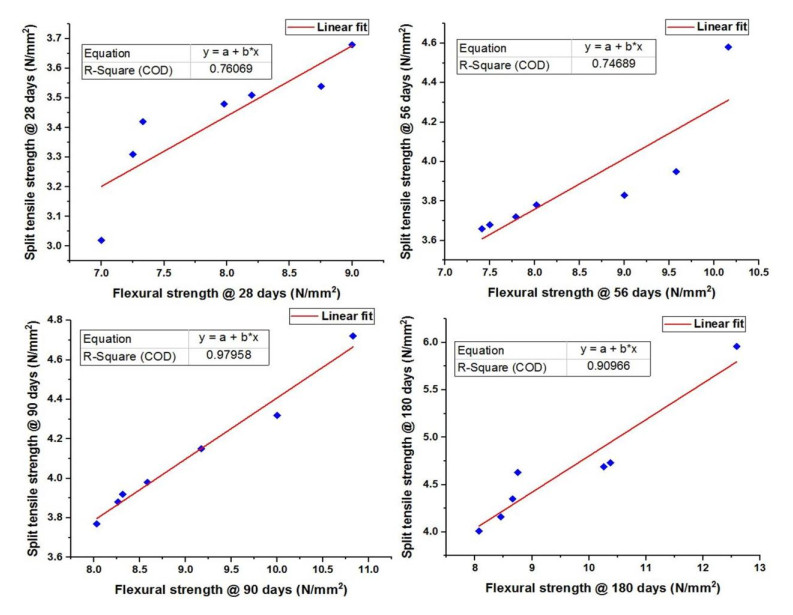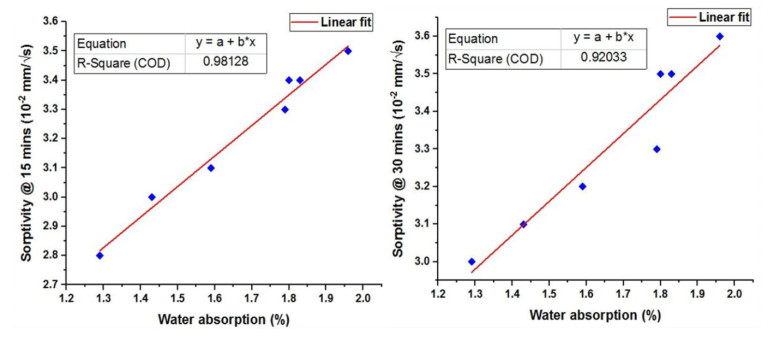This paper deals with the experiments conducted to study the effect of copper slag, GGBFS (Ground Granulated Blast Furnace Slag), metakaolin on the properties of concrete. While GGBFS and metakaolin are used as partial substitutes for cement, copper slag is used as a partial substitute for fine aggregate. This study investigates the mechanical strength of the concrete in terms of compressive strength, flexural strength, split tensile strength, bond strength and durability performance such as water absorption, porosity and sorptivity. In addition the effect of cement and fine aggregate substitution on the microstructure of concrete is also discussed. The results indicated improved strength properties with decreased cost consumption leading to greater efficiency and reduced river sand consumption as an additional benefit.
1.
Introduction
The quest for developing high quality and durable concrete by using industrial by-products and waste materials thereby reducing the disposal problem is the foremost aim of the present construction industry. Several new materials that have a promising future when used as ingredients in concrete are being introduced day-by-day. Copper slag is one such material which is now holding a peer importance in the present research works on construction materials [1]. Apart from the positive results reported by several researches on the potentials of using copper slag as partial substitute for cement and agammaegates the growing concern of preventing the depletion of natural resources makes copper slag an indispensable construction material [2]. Multiple research works have labelled and classified copper slag as an efficient fine agammaegate replacement material through a number of experimental works [3,4,5]. The beneficial use of copper slag as cement or fine agammaegate substitute have now been wide spread due to their mechanical and chemical characteristics coupled with the benefits of reduced cost consumption and environmental protection [6]. Despite several studies insisting the qualifying nature of copper slag as fine agammaegate only very few studies have attempted to investigate the ternary effects of substitution of supplementary cementitious material and copper slag on concrete [7,8,9]. Blast furnace slag is an excellent supplementary cementitious material that possess high amount of silica and alumina [10]. The use of metakaolin has also received enormous attention when used as a supplementary cementitious material [11]. The utilization of GGBFS and metakaolin has been attaining much attraction as a supplementary cementing material in recent decades [12]. Several studies have shown the efficiency of copper slag, fly ash, GGBFS and metakaolin as a possible substitution material for cement and fine agammaegate [13]. However the potentiality of adding copper slag as fine agammaegate to the ternary blended cement concrete containing GGBFS and metakaolin through experimental validation still lag behind.
The workability as well as the mechanical properties of concrete is raised by copper slag addition [14]. The free lime content in ordinary cement is higher than copper slag cement which enhances the compressive strength of concrete [15]. The pozzolanic action of optimum content of metakaolin lowers CH content which produces better workability of concrete [16]. Up to the particular content of metakaolin, the compressive strength is raised by the pozzolanic action and its filling action. After that particular content, the strength is lowered by the dilution effect [17]. The similar behavior is obtained for the flexural strength and split tensile strength regarding to metakaolin addition [18,19]. The pozzolanic action of metakaolin consumes portlandite content which improves porosity of concrete [20]. The durable properties such as porosity and sorptivity are improved by the filling capacity and pozzolanic activity of metakaolin [21]. The micro structural property of concrete is upgraded with the addition of metakaolin [22]. Similarly the metakaolin concrete has better micro structure than ordinary concrete [23]. The GGBFS produces better concrete than ordinary concrete in the aspects of mechanical, durable and microstructural properties [24,25,26]. The concrete with the pozzolanic materials such as GGBFS and metakaolin produce better bond strength than ordinary concrete [27]. The discharge of greenhouse gases (which are the major reason for global warming) throughout the course of hydration and production of cement is very large. In this paper, the metakaolin and GGBFS are utilized for replacing the cement. The two main characteristics of copper are their angular sharp edges and low water absorption which modifies the concrete properties in many ways especially in mechanical property. The special characteristic of metakaolin is the large surface area and pozzolanic action that modifies the durable and mechanical properties in positive ways. Similarly the durable and micro structural properties are altered by the pozzolanic and filling activity of GGBFS.
This research is performed to examine the potentiality of using copper slag as sand replacement in ternary blended cement concrete containing GGBFS and metakaolin. The ultimate aim of the research work can be as follows:
1. To minimize the river sand usage as agammaegate thereby reducing the scarcity of natural resources.
2. To maximize the utilization of industrial wastes as alternative to natural agammaegate.
3. To analyse the effect of replacement of cement by GGBFS and metakaolin and their contribution to the durability property of concrete.
From the previous study, it is understood that many research works have been done by using copper slag as individual replacement for sand. And also the researches have been done by replacing cement by individual GGBFS and metakaolin or the blends of these two materials. There are no studies available by combining these three materials together to improve the performance of concrete. Hence in this paper, the above three materials copper slag, GGBFS and metakaolin are simultaneously replaced in concrete mixture for sand and cement respectively. The combined effect of these ternary materials upgrades the characteristics of concrete more than individual or binary materials replacement. At the same time, the industrial wastes such as copper slag and GGBFS are effectively utilized together in this research work to produce the sustainable environment.
Each and every replacement material has their own different specific characteristics which influences the property of concrete in positive and negative ways. Based on the literature survey, the optimum replacement level gives positive influence in improving the concrete properties. The range of fixation of the replacement material level is evaluated from the optimum content which gives maximum strength to concrete. The literature studies reveal that the most of the best strength results are obtained for 10 to 50 % copper slag replacement level. In a similar way, the most excellent strength results are established by the replacement level of below 20% of individual GGBFS and metakaolin. According to the observations, the range of replacements is fixed as 20 to 60%, 5% to 10% and 5% to 10% for copper slag, GGBFS and Metakaolin and respectively. The mix proportions of the three material combinations are varied in each and every mix and the experiments are carried out to find which mix proportionality is best for producing better concrete. Here in this study, the mechanical property, durable property and micro structure property are observed in ternary replacement concrete mixture and found to be enhanced compared with earlier studies.
2.
Materials and methodology
M30 grade concrete was prepared as per the guidelines given in IS 10262-2009 [28]. The control concrete mixes constituted ordinary Portland cement, fine agammaegate (river sand), super plasticizer (naphthalene based) and water (0.38). Six types of concrete mixes containing varying proportions of copper slag, metakaolin and GGBFS are produced. Metakaolin and GGBFS as partial substitutes for cement in proportions of 5% and 10% and copper slag as sand substitute in contents of 20%, 40% and 60% were used. The byproduct of steel manufacturing industry is GGBFS (Ground Granulated Blast Furnace Slag). The byproduct of copper extraction is copper slag. The particle size distribution and chemical composition of the materials used in the study are shown in Figure 1 and Table 1 respectively. Table 2 shows the concrete mix proportions and mix designations. From the table, the replacement of metakaolin and GGBFS is 5% and 10% by the weight of cement. The replacement of copper slag is 20%, 40% and 60% by the weight of sand. The slump cone test was carried out as per IS: 1199-1959 for finding workability [29]. The compressive strength and flexural strength were carried out according to IS: 516-1959 [30]. The splitting tensile strength was carried out according to IS: 5816-1999 [31]. As per IS: 2770-Part1-1967, the pull out test was carried out [32]. As per IS: 2770-Part1-1967, the pull out test was carried outfor finding bond strength of concrete. The specimen of 150mm cube embedded at the centre of the specimen with a 16mm diameter bar of length 500mm length is tested and the bond strength is calculated by dividing the applied load at the slip specified, by the surface area of the embedded length of the bar. According to ASTM C 642, the water absorption and porosity of concrete were determined [33]. The sorptivity test was carried out as per ASTM C 1585 [34].
To assess the workability parameters of concrete mixes slump measurements were done at fresh state. The hardened state study included compressive strength, flexural strength, split tensile strength, water absorption, porosity and sorptivity.
3.
Results and discussions
3.1. Workability
The workability of the concrete as obtained from the slump test is shown in Figure 2. The influence of copper slag as fine agammaegate replacement shows that the workability of the concrete increases substantially with the increase in the percentage of copper slag. This improvement in the workability of the concrete due to the copper slag addition may be attributed to the surface glassy texture of the copper slag and less water absorption capacity of the copper slag compared to the normal sand that increases the amount of free water available in the concrete [4,9]. This amount of free water available in the copper slag incorporated concrete is much higher than that of the normal concrete and is the main causative agent of the workability improvement in the copper slag substituted concrete whereas the metakaolin causes a negative influence on the workability of the concrete due to the property of agglomeration exhibited by the metakaolin particles. The compounding effect of metakaolin also leads to the reduction in the workability of the concrete which indicates that as the content of metakaolin increases in the concrete the workability of the concrete is greatly affected. The addition of metakaolin also enhances the flocculation effect on the cement matrix thus delivering minimal slump values and lesser workability [16,20]. However the addition of GGBFS compensated the negative effects caused by the metakaolin. The addition of GGBFS as cement replacement in the concrete enhances the workability of the concrete due to the surface characteristics of the slag particles and smoothness, denseness and less water absorbing capacity of the slag particles [10]. The ability of the slag particles to fill the spaces caused by the agglomeration of the cement and metakaolin particles and also to act as a lubricant for reducing the frictional forces between the cement matrix and agammaegates cause increase in the flowability of the concrete mixes.
3.2. Compressive strength
The compressive strength results of the concrete mixes are shown in Figure 3. It is clearly seen that the concrete specimen using copper slag as fine agammaegate increased the compressive strength of the concrete at all ages. The Figure clearly shows that the copper slag replacement proves to be efficient in improving the compressive strength of the concrete beyond which the compressive strength gradually decreases [1,14]. The higher compressive strength of the mixes containing copper slag replacement was mainly due to the fact that the copper slag exhibits higher compressibility than the normal sand. It can also be seen that the percentage of copper slag plays a dominant role than the metakaolin and GGBFS in improving the compressive strength of concrete. The copper slag is effective in increasing the compressive strength of the concrete and at the same time addition of metakaolin and GGBFS also increases the strength of the concrete to a greater extent [13]. In all the mixes of concrete the increasing metakaolin content causes a negative influence on the compressive strength of concrete due to the property of agglomeration exhibited by metakaolin. However the negative influence of metakaolin on the compressive strength was compensated by the addition of GGBFS that improved the compressive strength at all curing agents. However it is clearly shown that increasing the percentage of replacement of fine agammaegate by copper slag at higher levels caused a negative influence on the compressive strength of the concrete. The metakaolin content also contributes to strength improvement due to their properties such as the filler effect, pozzolanic reaction of metakaolin with calcium hydrate and the compounding effect of metakaolin [17]. The compounding effect of metakaolin is also significant in the concrete mix containing copper slag as fine agammaegate replacement because of the non-water absorbing capacity of the copper slag that increases the amount of free water available thereby leading to bleeding and inversely affecting the compressive strength of the concrete. This compounding effect of metakaolin neutralizes the effect of copper slag in comparison with normal sand that increases the workability whereas effects the compressive strength of concrete. Thus the combined effect of metakaolin and copper slag is counter balancing and provides favourable strength results.
3.3. Flexural Strength
The results obtained from the flexural strength of the concrete specimens at various ages of 14, 28, 56, 90 and 180 days are shown in Figure 4. The results indicate that the copper slag as fine agammaegate replacement combined with metakaolin and GGBFS shows significant flexural performance than the ordinary Portland cement concrete. The improved flexural strength of the copper slag substituted concrete blended with metakaolin and GGBFS may be due to the filler effect of the metakaolin and GGBFS and higher fineness of copper slag with large surface area [13]. The physical properties of copper slag such as higher compressibility helped in the partial relief of the concentration of stresses. Moreover the angular shape of the copper slag also improves the cohesion of the copper slag and the cement matrix thus improving the strength of the concrete [2,9]. The rough surface and high abrasion property of the copper slag can also improve the cohesion between the cement pastes and agammaegate which is also an important factor for the strength improvement. The improvement in compressive strength of concrete at the later ages of the mix containing the copper slag replacement than the normal concrete is due to the negative property of the sand which gets weakened with time and also due to the weathering property of the sand which is said to have round edges whereas the angular property of the copper slag improves the interlocking capacity of the agammaegates with the cement matrix.
3.4. Split tensile strength
The splitting tensile strength of the concrete is shown in Figure 5 which clearly shows the improved split tensile strength exhibited by the concrete mixes at all ages. This improved split tensile strength of the mix may be attributed to the presence of metakaolin and GGBFS combined with the effect of copper slag replacement. The angularity of the copper slag and surface texture of the metakaolin and GGBFS contributed towards increasing the split tensile strength of the concrete [4,19]. The values also indicate that the rate of improvement in the split tensile strength of the concrete was also higher for the concrete which contained metakaolin and GGBFS as cement replacement. This is due to the active reaction of the metakaolin and GGBFS in the formation of reaction products with higher strength than the normal concrete.
3.5. Bond Strength
Figure 6 shows the bond strength of the various concrete mixes. No significant improvement in the bond strength was obtained for the concrete mixes containing higher percentage replacement of copper slag. The decrease in the bond strength observed at higher percentage substitution of copper slag may be due to their surface texture that facilitated easier pull out of the rods from the specimen. The bond strength of some concrete mixes at minimal percentage substitutions of copper slag was observed to be higher than the normal concrete. The improvement in the bond strength followed the same trend of split tensile strength of the concrete and this further confirms that the higher splitting tensile strength of the concrete improves the shear resistance of the concrete and thereby increases the bond strength between the concrete and the steel bar. The improved bond strength of the concrete mixes can be attributed to the substitution of cement by metakaolin and GGBFS which created better chemical and physical adhesion of the concrete to the surface of the steel bar. The increase in the bond strength of the concrete may also be due to the improvement in the mechanical interlocking behaviour of the concrete due to the increase in the fineness of the cement matrix by substituting metakaolin and GGBFS that possess high specific surface area [27]. The formation of highly dense reaction products with the consequent increase in the denseness and compactness of the concrete also led to the increase in the bond strength of the concrete.
3.6. Water absorption
The water absorption of the concrete mixes expressed as a percentage is shown in Figure 7. It can be clearly observed that the amount of water absorbed by the concrete mixes increased with increase in the percentage of copper slag replacement. The increase water absorption of the copper slag replaced concrete specimen may be due to the high amount of pores created by the addition of copper slag in concrete [1,4]. Moreover the addition of copper slag caused the increase in the excessive free water content in the concrete mixes that caused the particles of the concrete to separate leaving large amount of pores in the hardened concrete. These pores are easily accessible to water. In addition the filling capacity of the metakaolin that reduces the pores of the concrete and also the inclusion of metakaolin forms the stable non water soluble reaction products that fill the pores of the concrete. The metakaolin and GGBFS addition causes reduced water absorption of the concrete by making the pores discontinuous due to their pore blocking effect [10,12]. Moreover the addition of copper slag proves to be beneficial in reducing the water absorption percentage of the concrete up to a certain extent beyond which causes an increase in the water absorption of the concrete.
3.7. Porosity
The porosity of the concrete specimens is also shown in Figure 7. The filler effect of the metakaolin and GGBFS occupied the voids accessible to water and thus effectively reducing the porosity [25]. Moreover the increased specific surface area of the metakaolin creates increased number of reaction sites that actively react with the cement forming pozzolanic reaction and hence aids in the formation of stable phases of concrete [20,22]. The higher fineness and denseness of the slag also contributes to the filling of the voids available in the concrete caused due to the addition of copper slag [15]. The porosity of the concrete is found to influence both the mechanical strength and durability of the concrete. It is also well established that the compressive strength of the concrete is proportional to the porosity of the concrete.
3.8. Sorptivity
The capillary absorption of the water by the concrete specimens and the sorptivity values of the concrete specimens obtained after 15 and 30 minutes are shown in Figure 8. The Figure clearly shows the positive influence of metakaolin and GGBFS in reducing the volume of permeable pore and thereby reducing the water uptake by the concrete [13]. The capillary water absorption of the concrete was also minimized due to the formation of stable reaction product formed when metakaolin and GGBFS interacts with the cement matrix and also with the surface of the agammaegates.
3.9. SEM
The SEM micrographs of the concrete mixes are shown in Figure 9. The dark spaces in the SEM images are said to be voids or pores. Thus it can be clearly seen that the amount of voids in the concrete was reduced for all the concrete mixes when compared to the normal concrete mix. The morphology of the concrete mixes was also modified to a greater extent due to the substitution of metakaolin and GGBFS for cement and copper slag for fine agammaegate. When compared to the normal concrete mix MC1 the other concrete mixes showed denser microstructure due to the filling effect caused by the metakaolin and GGBFS [24]. The granular phases of the concrete are also well shown in clear gray which corresponds the hydrated phases in the concrete. The interfacial transition zone between the cement matrix and the agammaegates also showed the well bonding of the agammaegates with the matrix. The pozzolanic action of the metakaolin led to the reduction in the formation of Ca (OH)2 thus improving the strength of the concrete [22,23]. This further shows the effect of metakaolin in improving the morphology of the concrete by densifying the matrix. This dense microstructure contributed to the high compressive strength of the concrete mixes. The beneficial effect of GGBFS in improving the surface morphology of the concrete is evident from the improved formation of CSH gel in the concrete. The GGBFS is capable of producing higher amount of CSH gel due to the reaction with alkali and Ca (OH)2 present in the cement. Thus forms CSH gel is found to denser in nature than that formed in normal concrete. Hence formed CSH gel densifies the morphology of the concrete subsequently reducing the porosity of the concrete. The plate like CSH gel formation is well shown in the microstructure images which formed flaky layer around the agammaegates giving good bonding strength to the concrete. The GGBFS and metakaolin replacement improved the pore structure of the concrete to a considerable extent. The uniform distribution and the dilution effect caused by the metakaolin and GGBFS refined the pores of the concrete which is shown by the more homogeneous and compact structure of concrete. Moreover the significant reduction in the pores of the concrete increases the compressive strength of the concrete by reducing the formation of gypsum and thaumasite in the concrete. His is consistent to the above obtained results that the strength of the concrete is directly proportional to the porosity of the concrete. The SEM images of the concrete containing higher copper slag percentages exhibited weakened pore structure. This may be due to the decrease in the cohesion of the particles in the concrete exhibited by the glassy structure of the copper slag. The SEM image also shows the presence of some unreacted metakaolin on the surface of the concrete structure which further confirms the relative weak in strength of the concrete mixes at higher copper slag replacement. The reduced formation of the hydration products with higher copper slag replacement also contributed to the weakening of the pore structure of the concrete. At higher replacement levels of copper slag the morphology of the concrete was affected due to the higher fineness of the fine agammaegate replacement that requires more gel formation to strengthen the formation of crystals thus making the pore structure of the matrix relatively looser.
3.10. Regression analysis
From the experimental data obtained the regression analysis was performed and the best model that fits the various parameters of the concrete was found. The proposed prediction equation and the corresponding R2 value obtained are shown in also in Figure 10, 11 and 12. The R2 value obtained were almost higher and shows that all the strength parameters of the concrete are inter-related to each other and thus follows a linear trend.
4.
Conclusions
From the experimental study conducted on the concrete by replacing the fine agammaegate by copper slag at various percentages and metakaolin and GGBFS as partial substitute for cement the following conclusions can be withdrawn.
1. In this article the copper slag is effectively utilized as concrete making material without disposing and dumping into the environment which is harmful to living and non-living creatures.
2. The workability of the concrete mixes improved with increase in the percentage of replacement of the fine agammaegate by copper slag. The addition of GGBFS also considerably improved the workability of the concrete. Thus the copper slag proves to be an effective substitute for fine agammaegate when the workability of the concrete is considered. This improved workability achievement even at low water binder content is advantageous in areas where the water scarcity is a great problem.
3. The compressive strength of the concrete was increased for all the mixes in which copper slag is used as fine agammaegate replacement and metakaolin and GGBFS as cement replacement. The compressive strength was almost doubled due to the copper slag substitution in comparison with the normal concrete.
4. The flexural strength of the concrete containing copper slag, metakaolin and GGBFS was also improved than the normal concrete. The replacement of fine agammaegate by copper slag and the addition of metakaolin and GGBFS proved to be beneficial in improving the flexural performance of the concrete.
5. The splitting tensile strength was also improved due to the substitution of fine agammaegate by copper slag and cement by metakaolin and GGBFS.
6. The water absorption behaviour of the concrete mixes containing higher percentage of copper slag proved to be detrimental to the performance of the concrete. Though copper slag does not absorb water the improved water absorption was due to the creation of free channels for easier movement of water due to the substitution of fine agammaegate by copper slag.
7. The porosity of the concrete was decreased due to the addition of copper slag at lower percentage substitution levels. The metakaolin and GGBFS proved to be efficient in filling the pores of the concrete.
8. The capillary water absorption of the concrete showed less amount of surface water absorbed for the concrete containing copper slag. The surface water absorption of the concrete was reduced mainly due to the filling behaviour exhibited by metakaolin and GGBFS.
9. The bond strength mainly depends on the compacity and density of the concrete. The bond strength of the concrete also improved response when metakaolin and GGBFS used as cement replacement and copper slag replacement for fine agammaegate. The addition of metakaolin and GGBFS improved the shear strength of the concrete which ultimately increases the bond strength of the concrete.
10. The microstructure studies conducted on the concrete mixes containing copper slag and GGBFS and metakaolin showed improved pore structure of the concrete. The addition of metakaolin and GGBFS reduced the pore size of the concrete which subsequently led to increase in the durability and strength performance of the concrete.
11. The regression analysis performed on the strength parameters of the concrete yielded models that exactly fit the experimental data. The proposed model also showed the inter dependency of the various strength parameters of the concrete with a clear understanding of the experimental results.
The final conclusion can be withdrawn that copper slag is the best substitute for final agammaegate and the metakaolin and GGBFS substitution for cement proves to be better solution to manufacture concrete with remarkable strength and durability. It is also suggested that the percentage of copper slag replacement to cement should be optimized by proper consideration to the strength parameters of the concrete.
Conflict of interest
The authors declared that there is no conflict of interest in publishing the manuscript.
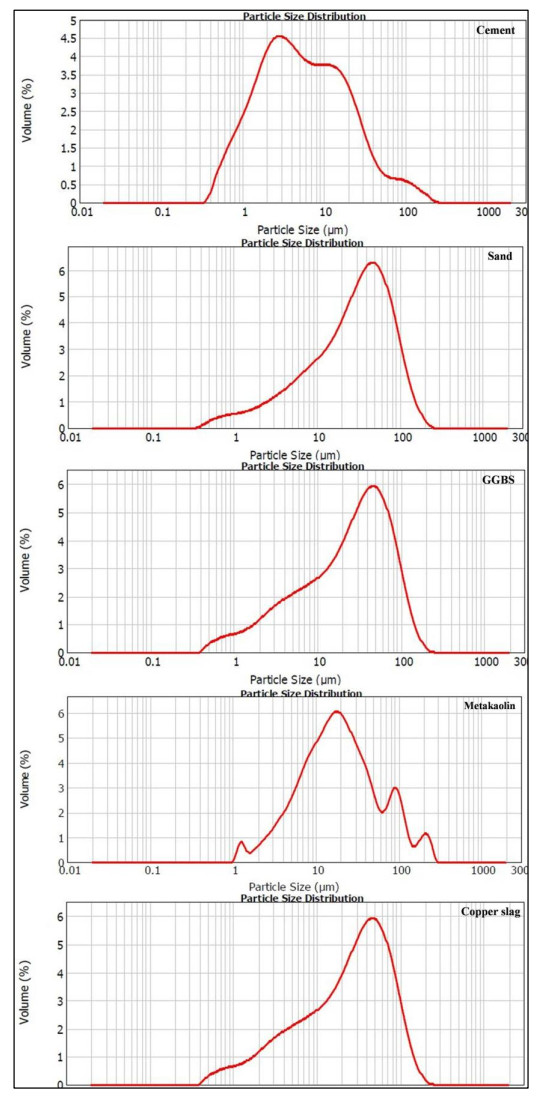









 DownLoad:
DownLoad:
